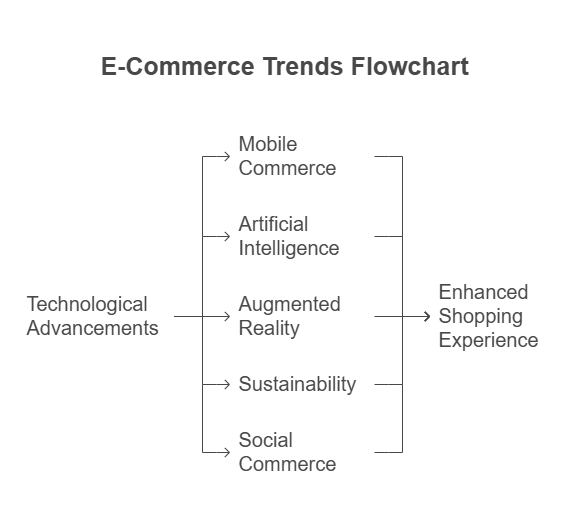In the last two decades, the way we shop has undergone a dramatic transformation. Gone are the days when buying something meant visiting a physical store, browsing through shelves, and standing in long queues to pay. Today, with just a few clicks or taps on a smartphone, we can order anything from groceries to gadgets and have them delivered to our doorstep. This revolution in shopping is thanks to the rise of e-commerce, a phenomenon that has reshaped the global economy and changed the way businesses and consumers interact.
In this article, we’ll explore the rise of e-commerce, its impact on our lives, and how it has become an integral part of the digital age. We’ll also look at the challenges it faces and what the future might hold for this ever-evolving industry.
What is E-Commerce
It includes everything from online retail stores like Amazon and eBay to digital marketplaces like Etsy and services like Uber and Airbnb. E-commerce isn’t just limited to physical products; it also encompasses digital goods like e-books, software, and streaming services.
The concept of e-commerce isn’t new. It dates back to the 1960s when businesses started using Electronic Data Interchange (EDI) to exchange documents electronically. However, it wasn’t until the 1990s, with the advent of the internet, that e-commerce truly took off. The launch of platforms like Amazon and eBay in the mid-1990s marked the beginning of a new era in retail.
The Rise of E-Commerce
The rise of e-commerce can be attributed to several factors, including technological advancements, changing consumer behavior, and the globalization of markets.
1. Technological Advancements
The internet is the backbone of e-commerce. Without it, online shopping wouldn’t exist. The widespread adoption of high-speed internet, smartphones, and mobile apps has made it easier than ever for people to shop online. Additionally, advancements in payment systems, such as digital wallets and secure online payment gateways, have made transactions seamless and secure.
2. Changing Consumer Behavior
Consumers today value convenience, speed, and variety. E-commerce offers all three. With online shopping, consumers can browse thousands of products, compare prices, read reviews, and make purchases—all from the comfort of their homes. The ability to shop 24/7 has also made e-commerce incredibly appealing.
3. Globalization of Markets
E-commerce has broken down geographical barriers. Businesses can now reach customers across the globe, and consumers can access products and services from anywhere in the world. This globalization has opened up new opportunities for businesses and created a more competitive marketplace.
The Impact of E-Commerce
The rise of e-commerce has had a profound impact on various aspects of our lives, from the way we shop to how businesses operate.

1. Convenience for Consumers
One of the most significant benefits of e-commerce is the convenience it offers. They can shop from anywhere, at any time, using their smartphones, tablets, or computers. This convenience has made online shopping a preferred choice for many, especially in urban areas where time is often a constraint.
2. Wider Product Selection
E-commerce platforms offer a vast array of products, often much more than what’s available in physical stores. Consumers can find niche products, international brands, and unique items that may not be available locally. This wide selection has empowered consumers to make more informed purchasing decisions.
3. Competitive Pricing
The transparency of pricing in e-commerce has led to increased competition among retailers. Online platforms allow consumers to compare prices across different sellers, forcing businesses to offer competitive pricing and discounts. This has ultimately benefited consumers, who can now get better deals online.
4. Job Creation and Economic Growth
While e-commerce has disrupted traditional retail, it has also created new job opportunities. From warehouse workers and delivery drivers to digital marketers and software developers, the e-commerce industry has generated millions of jobs worldwide. Additionally, e-commerce has contributed to economic growth by enabling small businesses and entrepreneurs to reach a global audience.
5. Environmental Concerns
While e-commerce offers many benefits, it also has its downsides. The increase in online shopping has led to a surge in packaging waste and carbon emissions from delivery vehicles. However, many e-commerce companies are now taking steps to address these issues by adopting sustainable practices, such as using eco-friendly packaging and optimizing delivery routes.
6. Impact on Traditional Retail
The rise of e-commerce has had a significant impact on traditional brick-and-mortar stores. Many retailers have struggled to compete with online giants like Amazon, leading to store closures and job losses. However, some traditional retailers have adapted by integrating e-commerce into their business models, offering both online and in-store shopping options.
Challenges Faced by E-Commerce
Despite its many advantages, e-commerce is not without its challenges. Some of the key challenges include:
1. Security Concerns
Online shopping involves sharing personal and financial information, which makes consumers vulnerable to cyberattacks and fraud. Ensuring the security of online transactions is a top priority for e-commerce businesses.
2. Logistics and Delivery
Efficient logistics and timely delivery are critical to the success of e-commerce. However, managing inventory, shipping, and last-mile delivery can be complex and costly, especially for small businesses.
3. Customer Trust
Building trust with customers is essential for e-commerce businesses. This includes providing accurate product descriptions, reliable customer service, and hassle-free return policies.
4. Competition
The e-commerce industry is highly competitive, with new players entering the market every day.
The Future of E-Commerce
The e-commerce industry is constantly evolving, driven by advancements in technology and changing consumer preferences. Here are some trends that are likely to shape the future of e-commerce:
1. Mobile Commerce
With the increasing use of smartphones, mobile commerce (m-commerce) is expected to grow significantly. Businesses are investing in mobile-friendly websites and apps to provide a seamless shopping experience on mobile devices.
2. Artificial Intelligence and Personalization
Artificial intelligence (AI) is being used to personalize the shopping experience for consumers. From product recommendations to chatbots, AI is helping businesses engage with customers in more meaningful ways.
3. Augmented Reality (AR)
Augmented reality is transforming the way consumers shop online. AR allows customers to visualize products in their real-world environment, such as trying on clothes or placing furniture in their homes, before making a purchase.
4. Sustainability
As consumers become more environmentally conscious, e-commerce businesses are focusing on sustainability. This includes using eco-friendly packaging, reducing carbon footprints, and promoting ethical practices.
5. Social Commerce
Social media platforms like Instagram and Facebook are becoming popular channels for e-commerce. Social commerce allows businesses to sell products directly through social media, making it easier for consumers to discover and purchase products.

Conclusion
The rise of e-commerce has revolutionized the way we shop and do business. It has brought unparalleled convenience, choice, and accessibility to consumers while creating new opportunities for businesses. However, it also comes with its own set of challenges, from security concerns to environmental impacts.
As we move further into the digital age, e-commerce will continue to evolve, driven by technological innovations and changing consumer expectations. Businesses that embrace these changes and adapt to the shifting landscape will thrive, while those that fail to keep up may struggle to survive.
E-commerce is more than just a trend; it’s a fundamental shift in the way we live and interact with the world. Whether you’re a consumer enjoying the convenience of online shopping or a business owner navigating the complexities of the digital marketplace, one thing is clear.
Frequently Asked Questions (FAQs)
1. What is e-commerce?
E-commerce refers to the buying and selling of goods and services over the internet. It includes online retail stores, digital marketplaces, and services like food delivery or ride-hailing apps.
2. How has e-commerce changed the way we shop?
E-commerce has made shopping more convenient, faster, and accessible. Consumers can now shop from anywhere, at any time, without visiting physical stores. It also offers a wider range of products, competitive pricing, and the ability to compare options easily.
3. What are the benefits of e-commerce for consumers?
- Convenience: Shop anytime, anywhere.
- Wider Selection: Access to a vast range of products, including niche and international items.
- Competitive Pricing: Easy price comparison and discounts.
- Time-Saving: No need to travel to physical stores.
- Reviews and Ratings: Make informed decisions based on other customers’ experiences.
4. What are the benefits of e-commerce for businesses?
- Global Reach: Sell to customers worldwide.
- Lower Operational Costs: No need for physical storefronts in some cases.
- Data-Driven Insights: Track customer behavior and preferences to improve offerings.
- 24/7 Availability: Businesses can operate around the clock.
- Scalability: Easily expand product lines or services.
5. What are the challenges of e-commerce?
- Security Risks: Cyberattacks and data breaches.
- Logistics and Delivery: Managing inventory and ensuring timely delivery.
- Customer Trust: Building and maintaining trust through reliable service and policies.
- Competition: Staying ahead in a highly competitive market.
- Environmental Impact: Packaging waste and carbon emissions from deliveries.
6. How does e-commerce impact traditional retail?
E-commerce has disrupted traditional retail by offering more convenience and competitive pricing. Many brick-and-mortar stores have struggled to compete, leading to closures. However, some retailers have adapted by integrating online and offline shopping experiences (omnichannel retail).
7. Is e-commerce safe?
E-commerce is generally safe, but it depends on the platform and the precautions taken by both businesses and consumers. Reputable e-commerce sites use secure payment gateways and encryption to protect customer data. Consumers should also practice safe online shopping habits, such as using strong passwords and avoiding suspicious links.
8. What is mobile commerce (m-commerce)?
With the rise of mobile apps and optimized websites, m-commerce has become a significant part of e-commerce.
9. How is artificial intelligence (AI) used in e-commerce?
AI is used in e-commerce to personalize the shopping experience. Examples include:
- Product Recommendations: Suggesting items based on browsing history.
- Chatbots: Providing instant customer support.
- Inventory Management: Predicting demand and optimizing stock levels.
- Visual Search: Allowing customers to search for products using images.
10. What is social commerce?
Social commerce is the integration of e-commerce into social media platforms. It allows businesses to sell products directly through platforms like Instagram, Facebook, and TikTok. Features like “Shop Now” buttons and live shopping events make it easier for consumers to discover and purchase products.
11. How does e-commerce affect the environment?
E-commerce can have a negative environmental impact due to excessive packaging waste and carbon emissions from delivery vehicles. However, many companies are adopting sustainable practices, such as using eco-friendly packaging, optimizing delivery routes, and offering carbon-neutral shipping options.
12. What is the future of e-commerce?
The future of e-commerce will likely be shaped by:
- Mobile Commerce: Increased shopping through smartphones.
- AI and Personalization: More tailored shopping experiences.
- Augmented Reality (AR): Virtual try-ons and product visualizations.
- Sustainability: Eco-friendly practices and products.
- Social Commerce: More shopping through social media platforms.
13. Can small businesses succeed in e-commerce?
Yes, small businesses can succeed in e-commerce by leveraging platforms like Etsy, Shopify, or Amazon. They can also use social media and digital marketing to reach their target audience. The key is to offer unique products, provide excellent customer service, and build a strong online presence.
14. What are some popular e-commerce platforms?
Some of the most popular e-commerce platforms include:
- Amazon: The largest online retailer globally.
- eBay: Known for auctions and second-hand goods.
- Shopify: A platform for businesses to create their own online stores.
- Etsy: Focused on handmade, vintage, and unique items.
- Alibaba: A leading platform for wholesale and international trade.
15. How can consumers protect themselves when shopping online?
- Use strong, unique passwords for online accounts.
- Shop only on secure websites (look for “https” in the URL).
- Avoid clicking on suspicious links or pop-ups.
- Use trusted payment methods like credit cards or secure digital wallets.
- Check reviews and ratings before making a purchase.
16. What is the role of logistics in e-commerce?
Logistics plays a crucial role in e-commerce by ensuring that products are stored, packed, and delivered to customers efficiently. Fast and reliable delivery is a key factor in customer satisfaction, and many e-commerce companies invest heavily in optimizing their supply chains.
17. How has COVID-19 impacted e-commerce?
The COVID-19 pandemic accelerated the growth of e-commerce as lockdowns and social distancing measures forced consumers to shop online. Many businesses that previously relied on physical stores shifted to online sales, and new consumers adopted e-commerce for the first time.
18. What is the difference between B2B and B2C e-commerce?
- B2B (Business-to-Business): Transactions between businesses, such as manufacturers selling to retailers.
- B2C (Business-to-Consumer): Transactions between businesses and individual consumers, like an online store selling directly to customers.
19. How does e-commerce support globalization?
It enables small businesses to compete on a global scale and gives consumers access to products and services from different countries.
20. What are some examples of successful e-commerce companies?
- Amazon: A global leader in online retail.
- Alibaba: Dominates the Chinese market and operates globally.
- Shopify: Empowers small businesses to create online stores.
- Zalando: A leading European fashion e-commerce platform.
- Walmart: Successfully integrated e-commerce into its traditional retail model.
